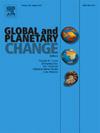高海拔祁连山及其对中新世晚期构造和生物多样性的启示
IF 4
1区 地球科学
Q1 GEOGRAPHY, PHYSICAL
引用次数: 0
摘要
准确重建祁连山的古海拔高度,对于推动我们理解青藏高原隆升模型的完整性、其深层构造机制以及与气候、环境和生物多样性变化的相应联系至关重要。最近,利用创新的古乐彩网学古海拔高度-TP/TPAP[(Tsuga% + Podocarpus%)/(Tsuga% + Podocarpus% + Abies% + Picea%)]比值,首次完成了青藏高原北部古海拔范围(即盆地和山脉的平均海拔)的定量重建,揭示了中新世晚期青藏高原北部从低海拔向高海拔的快速隆升。在此,我们分析了祁连山红崖子盆地的鄂博图动物群花粉记录(13-12 Ma),以直接推断该地区的古海拔高度。花粉组合主要由针叶树类(平均占 64.0%)组成,包括松科的松柏属、杉木属、松属以及濯缨松科,阔叶树类和草原类各占 15%。这种花粉组成明显反映了以高山针叶林为主的植被类型,与柴达木盆地的中新世花粉组合一致。应用TP/TPAP比率得出13-12Ma时的古海拔范围为3492 ± 87 m。结合这一时期柴达木盆地的已知海拔高度(1885 ± 566 米),计算出祁连山的海拔高度为 4338 ± 653 米。这种高海拔地形为地壳缩短和增厚导致的TP多级对流清除模型提供了证据支持。这也导致了祁连山针叶林为主的湿润生态系统的形成,为哺乳动物类群的多样化提供了支持。本文章由计算机程序翻译,如有差异,请以英文原文为准。
High-elevation Qilian Mountains and its inspiration for tectonics and biodiversity during the late Middle Miocene
The accurate paleoelevation reconstruction of the Qilian Mountains is critical to advancing our understanding the integrity of the Tibetan Plateau (TP) uplift model, its deep structural mechanisms, and corresponding connections with climatic, environmental, and biodiversity changes. Recently, the first quantitative reconstruction of the paleomidrange (i.e., average elevation of the basin and mountains) of the northern Tibetan Plateau (NTP) was completed, using innovative palynological paleoaltimetry-TP/TPAP [(Tsuga% + Podocarpus%) / (Tsuga% + Podocarpus% + Abies% + Picea%)] ratios, which revealed a rapid uplift of the NTP from low to high elevations during the late Middle Miocene. Here, we analyzed the Ebotu Fauna pollen record (13–12 Ma) from the Hongyazi Basin, situated within the Qilian Mountains, to directly infer the paleoelevation of this region. The pollen assemblages were predominantly composed of conifers (average of 64.0 %), including Picea, Cedrus, and Pinus of the Pinaceae, as well as Cupressaceae, with broadleaves and steppes taxa each accounting for <15 %. This pollen composition evidently reflects a vegetation type dominated by high-mountain conifers forest, consistent with Middle Miocene pollen assemblages from the Qaidam Basin. Application TP/TPAP ratios yielded a paleomidrange of 3492 ± 87 m at 13–12 Ma. Combined with the known elevation of the Qaidam Basin during this period (1885 ± 566 m), the elevation of the Qilian Mountains was calculated to be 4338 ± 653 m. In turn, an elevation of 2646 ± 740 m was obtained for the Hongyazi Basin. This high-elevation terrain provides evidence to support the multi-stage convective removal model of the TP caused by crustal shortening and thickening. It also led to the formation of a humid ecosystem dominated by conifers forest in the Qilian Mountains, supporting the diversification of mammalian taxa.
求助全文
通过发布文献求助,成功后即可免费获取论文全文。
去求助
来源期刊

Global and Planetary Change
地学天文-地球科学综合
CiteScore
7.40
自引率
10.30%
发文量
226
审稿时长
63 days
期刊介绍:
The objective of the journal Global and Planetary Change is to provide a multi-disciplinary overview of the processes taking place in the Earth System and involved in planetary change over time. The journal focuses on records of the past and current state of the earth system, and future scenarios , and their link to global environmental change. Regional or process-oriented studies are welcome if they discuss global implications. Topics include, but are not limited to, changes in the dynamics and composition of the atmosphere, oceans and cryosphere, as well as climate change, sea level variation, observations/modelling of Earth processes from deep to (near-)surface and their coupling, global ecology, biogeography and the resilience/thresholds in ecosystems.
Key criteria for the consideration of manuscripts are (a) the relevance for the global scientific community and/or (b) the wider implications for global scale problems, preferably combined with (c) having a significance beyond a single discipline. A clear focus on key processes associated with planetary scale change is strongly encouraged.
Manuscripts can be submitted as either research contributions or as a review article. Every effort should be made towards the presentation of research outcomes in an understandable way for a broad readership.
 求助内容:
求助内容: 应助结果提醒方式:
应助结果提醒方式:


